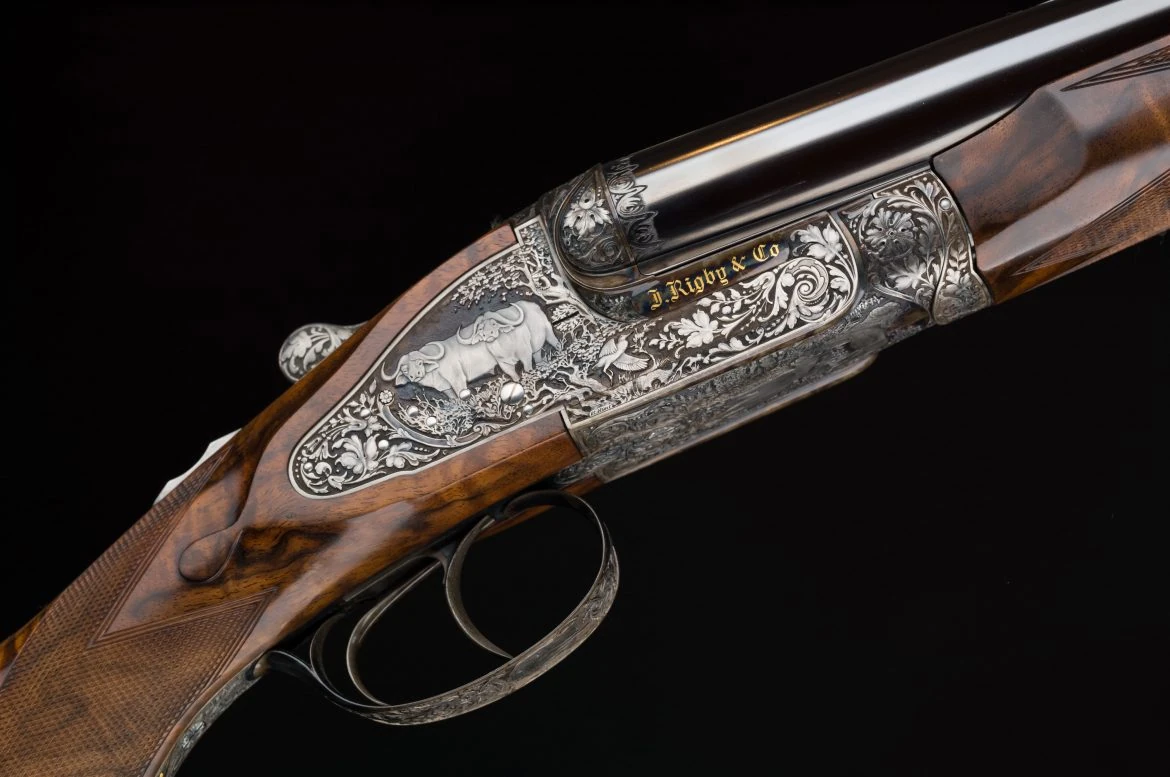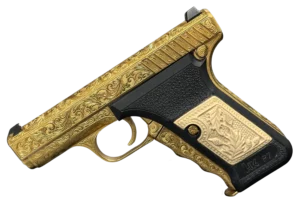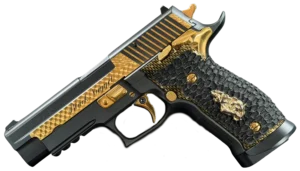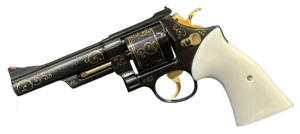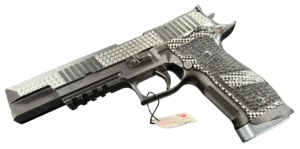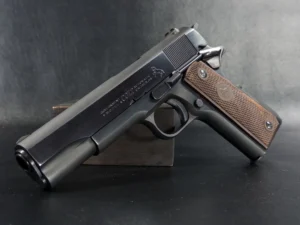- Firearms engraving isn’t just decoration — it’s storytelling in steel: From the first etched flintlocks in the 1500s to the hand-cut masterpieces of Alvin A. White, engraving has always been a way to give a firearm a soul. These aren’t just tools. They’re personal, historical, and often emotional objects, shaped by the hands (and obsessions) of true artisans.
- Technology might speed things up, but it can’t replace the human touch: Laser engraving and CNC machines can mimic patterns, sure — but they can’t replicate the rhythm, patience, or imperfections that give hand-engraved firearms their magic. Collectors know the difference. And they still chase that quiet brilliance only a master engraver can deliver.
- The value of a firearm goes way beyond make and model: It’s not just about rarity or condition — it’s about story. Who held it? Who made it? What art was etched into its surface? The most treasured guns are those that carry history, craftsmanship, and a hint of mystery in every line.
There’s something a little wild — and kind of beautiful — about the idea of turning a weapon into a canvas.
Firearms engraving has always lived in that strange, compelling tension: part utility, part luxury, part legacy. It goes way back, too. We’re talking 1500s Europe — when craftsmen first started carving ornate designs into swords and guns, transforming cold steel into something that told a story. Maybe it was pride. Perhaps it was showing off. Probably both.
Fast forward a few centuries, and you’ll find that tradition is still alive and kicking. Especially in the hands of engravers like Alvin A. White — a name you’ve probably heard if you’ve spent any time around high-end Colts or deep-cut American gun history. But we’ll get to him in a bit.
Right now, let’s walk through how we got here, who left their mark (literally), and why these engraved firearms aren’t just collectors’ items — they’re time capsules.
Alvin A. White: When Craftsmanship Becomes Legend
Let’s say it outright: Alvin Alexander White wasn’t just good. He was “top of the mountain” good. The kind of artist whose name gets spoken with reverence by collectors, historians, and other engravers alike.
But he didn’t start at the top. Before WWII, he was cutting dies — a hands-on, detail-heavy job that set the stage for everything he’d later do with metal and engraving tools. During the war, he served in the U.S. Army Air Corps. Afterward, in the 1950s, he found his true calling: engraving firearms for Colt. Eventually, he earned the title of Master Engraver. And honestly? It fit.
What made White special wasn’t just his technique, though; make no mistake, his scrollwork and inlays were mesmerizing. It was the way he made every piece feel personal, like it had a soul.
Some of his work went to the president. Literally. John F. Kennedy. Ronald Reagan. But he wasn’t some aloof artist who only worked for the elite. White also took on private commissions, putting the same level of care into a revolver for a lifelong collector as he did for a head of state.
His collection — part of which was featured at Rock Island Auction Company’s Premier Auction — is a masterclass in how to turn cold steel into warm narrative. From classic Single Action Army revolvers to miniature Old West keepsakes, everything he touched carried that unmistakable White signature: precise, historical, and quietly bold.
A personal standout? A Remington Model 14 — the very first firearm White ever engraved. It’s poetic. That, along with a hand-carved flintlock long rifle made from wood near his childhood home, shows you something most bios miss: the guy wasn’t just skilled — he was connected. To his tools. His roots. The whole American firearms story.
From Swords to Scrolls: How Firearms Engraving Took Shape
Engraving didn’t start with guns. It began with blades. Early craftsmen etched swords and daggers long before firearms even existed. But once gunpowder entered the picture, so did the urge to decorate what carried it.
In the 1800s, particularly in America, engraving gained immense popularity. Gunmakers started hiring in-house artists — real masters — to add flourishes, scrolls, and personalized designs to rifles and revolvers. This wasn’t just decoration; it was a marketing strategy. A fine engraving could turn a mass-produced firearm into something unique — a status symbol, even.
The Civil War era took this a step further. Engraved firearms became prized gifts, commemorations, and heirlooms. Guns weren’t just tools anymore. They were art. Family history. Americana in metal.
Of course, like everything else, technology changed the game. CNC machines and laser engravers now do in seconds what once took days. And yeah, that’s impressive. But here’s the thing: real collectors? They still crave the human touch. The tiny imperfections. The deliberate choices. The soul of hand-engraved metal.
Meet the Masters: Artists with a Burin and a Vision
Alvin White wasn’t alone in elevating the art. Here are a few more engravers who helped define — and redefine — what firearms engraving could be:
Richard Boucher
If you’ve ever seen a custom Colt 1911 so intricate it made you stop and stare, there’s a good chance Boucher’s name was behind it. Working with Pachmayr Custom Gunsmiths, he specialized in scrolls, gold inlay, and visual drama. One of his standout pistols had 24-karat gold on a French Grey finish, with aged ivory grips that somehow made it feel both timeless and ghostly. That’s Boucher in a nutshell — precise, showy, and unforgettable.
Jan Gwinnell
Rising to master engraver at Colt in just five years? That’s no small feat. Gwinnell’s work often features matching sets, like his serialized pair of Colt Single Action Army revolvers — silver-plated, checkered ivory grips, the whole nine yards. Factory-confirmed pairs like these aren’t just rare. They’re historical snapshots.
Kelly Laster
If you’ve never seen a Cattle Brand-style engraving, Laster’s work will stop you in your tracks. He started self-taught — a bold move — before refining his skills at the legendary Bottega Incisioni Cesare Giovanelli in Italy. His revolvers look like they’ve lived a hundred ranch lives. Brands etched in punch-dot backgrounds, mirror-bright Nickel finishes, and bold black Buffalo Horn grips — it’s the Old West, refined.
Bill Mains
Ever seen a revolver fit for a crooner? Mains worked with big names like Frank Sinatra and Elvis Presley — not exactly your average clientele. He was known for his hand-engraved Colts, often signed with a discreet little buffalo stamp. One of his pieces, a nickel-plated Single Action Army with Factory Class “B” scrolls, feels like something you’d find in a velvet case under a spotlight.
Ben Shostle
Founding member of the Firearms Engravers Guild of America. Deep relief engraving. Subtle gold bands. Understated excellence. Shostle’s style leaned toward quiet mastery — less flash, more soul. One of his 1993 Colts, with mother-of-pearl grips and 24k gold inlays, shows his minimalist genius. And here’s the kicker — even after he lost his sight later in life, his legacy never dimmed. That’s the kind of reverence he earned.
What Makes a Gun Collectible? (Spoiler: It’s Not Just Age)
If you’re into collecting, you’ve probably already heard the “Five Pillars” — the core factors that make a firearm valuable. But here’s the unvarnished version:
1. Make and Model
Some guns have that magic combo of design, function, and backstory. Think: Colt Single Action Army. It’s not just about who made it — it’s how it shaped history. These guns are more than brands; they’re cultural icons.
2. Condition
This one’s tricky. Everyone wants mint condition, sure. But a minor wear? The right kind of wear — holster marks from a lawman, honest scuffs from use — that can boost the appeal. Character counts.
3. Rarity
Rare doesn’t always mean valuable. But rare and interesting? That’s the sweet spot. Limited runs, prototype models, factory anomalies — if there’s a story and people care, value follows.
4. History
Who owned it? Where was it used? Did it show up in a famous conflict or pass through a renowned hand? Provenance matters. A well-documented history can be worth as much as the gun itself.
5. Art
This is where engraving comes in. Pure craftsmanship. Guns like the ones Alvin White and company worked on aren’t just mechanical — they’re aesthetic. That artistic value transforms them from tools into treasure.
Looking Ahead: What’s Next for the World of Engraved Firearms?
We’re in a weirdly exciting place right now. On one hand, technology is making custom work more accessible than ever. On the other hand, there’s a growing hunger for the real stuff — the hand-cut, soul-deep engravings that machines still can’t quite replicate.
Collectors, especially younger ones, are starting to appreciate engraving in a new way. Not just as decoration, but as a statement. A way to connect the past to the present. And frankly, to stand out in a world of sameness.
Artists like Alvin A. White didn’t just decorate metal. They gave it voice. And their legacy isn’t going anywhere. As long as there are stories to tell and steel to carve, someone will be holding a burin and chasing those lines — slowly, meticulously, maybe even a little obsessively.
Because some crafts don’t die, they evolve.
Final Thought (if you’ll humor one more):
You don’t need to be a collector or historian to appreciate engraved firearms. You need to hold one, run your fingers over the lines, and feel—feel that someone sat down, tool in hand, and made this. Not for speed. Not for mass production. Just for the love of it.
And that? That never goes out of style.
Frequently Asked Questions
At its core, engraving is the art of carving designs into a firearm, ranging from simple scrollwork to elaborate gold inlays and miniature scenes. But it’s more than just decoration. It’s history, legacy, and personal expression etched in metal. Engraving transforms a gun from a functional object into a memorable one.
Alvin White was one of the most respected American firearms engravers of the 20th century — a true master. He worked with Colt, engraved pieces for presidents like JFK and Reagan, and mentored a generation of talented engravers. His work isn’t just admired — it’s collected, studied, and cherished.
Both exist, and each has its place. Laser and CNC engraving are faster and more affordable, sure. But traditional hand engraving? That’s where the real artistry lives. It’s slower, more personal, and still very much alive among collectors and master engravers who care about the craft.
Look at the big picture: who engraved it, what the firearm is, how rare it is, and what kind of condition it’s in. Provenance helps too — if the piece has a story, especially with documentation, it’s more likely to catch a collector’s eye (and wallet).
Not at all — unless it’s purely decorative and never meant to be fired (which does happen with presentation pieces). Otherwise, a well-engraved firearm will function just like any other. It just looks a whole lot better doing it.


